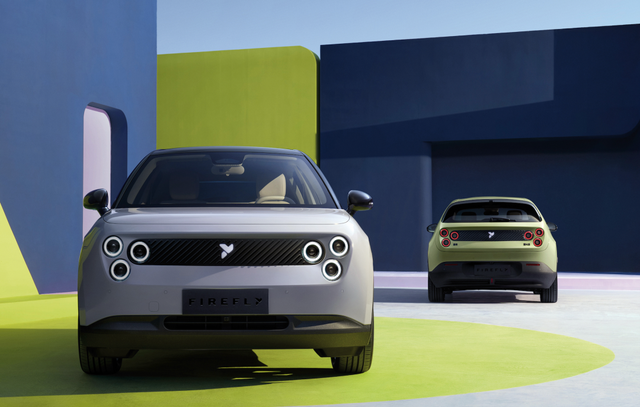Every year, new players in the automotive industry make their appearance, and since 2019, NIO may once again become the center of attention in 2025.
From Firefly's distinctive three-lens headlight design to the market’s misunderstanding of Le Dao's forced employee car purchases, the automotive world has once again started the year by teaching Li Bin how to run NIO well and avoid bankruptcy.
Amid renewed high pressure from the industry, NIO’s new brand – Firefly – is about to launch its first car in April. This vehicle will set the tone for NIO’s 2025 development, including whether it can withstand the inevitable negative backlash.

NIO has lowered its pricing from the 400,000-yuan luxury car segment to the 100,000-yuan entry-level market. This sharp price reduction has undoubtedly made many worries for the brand.
Whether it’s the Mercedes smart, BMW MINI, or Zeekr MIX, boutique small cars have always meant small production volumes, or a low-key entry-level positioning. Iconic global models like the Golf, Fit, and Yaris that once achieved explosive sales are now nearly impossible to replicate in China.
New automakers like Xpeng and Leap Motor have already established a foothold in the 100,000-yuan market. So why does Firefly, with its attention-grabbing design, believe it can break through this segment?
What sets Firefly apart is the backing of NIO. With its battery swap and service system, Firefly can offer the same level of service typically found in 400,000-yuan cars, something few other automakers can provide at this price point.

Apart from ultra-luxury brands like Rolls-Royce and Bentley, whose services are not familiar to the general public, NIO’s unique service system is nearly unbeatable in the entire automotive market.
The new energy vehicle market is accelerating its transition toward hybrid models, but NIO is not looking back. Li Bin has already created a nationwide battery swap system for all NIO users, making it one of the world’s strongest “range-extended hybrids” in a sense.
In addition, whether it's the traditional dealership systems or the direct-sales stores of new automakers, only NIO has placed customer service at the pinnacle of its priorities. Just browsing the variety of products in NIO's online store gives you a glimpse of this focus.
Firefly is not just a uniquely designed 100,000-yuan small car; it is the culmination of NIO’s 10 years of development. Li Bin has infused it with all the advantages and resources that NIO has accumulated over the past decade.

The reason is simple: car manufacturers must make every inch count in small cars, where there is no room for waste or error.
In this regard, Japanese cars have long been ahead of the curve. They must be both refined and utilize every millimeter of space efficiently. Even the few new energy vehicles produced by Japanese manufacturers are concentrated in the small and light car segments.
Firefly is a global brand created by NIO, and it fully matches the standards of global luxury small cars in terms of texture, quality, and craftsmanship. The European market, where it is expected to debut, is known for being the hub of luxury small cars, so we can expect high ambitions for Firefly in this area.
Winning the reputation it deserves will be a difficult path for Firefly, one fraught with challenges and risks, as it has no successful case studies to draw on in the Chinese market. However, the full suite of NIO’s capabilities makes the possibility of Chinese boutique small cars a reality once again.

Although the Honda Fit GK5's status as a "god car" has long since disappeared, and Toyota’s Yaris and Corolla Hatchback models have exited the Chinese market, China’s automotive industry deserves a global "god car" in the new energy vehicle era.
Of course, Firefly still has a lot of work to do to become a legendary car, and failure is highly likely, especially given the competitive traps set by rivals for NIO.
After WM Motor, HiPhi, and Neta encountered setbacks, Li Auto’s sales remain stable, while Leap Motor and Xpeng are beginning to show growth. Meanwhile, NIO’s sales have stagnated, making it the focal point of negative sentiment in the new carmaker market.
The Chinese automotive market has entered a vicious cycle where only sales matter. Automakers with good sales are granted higher tolerance, and NIO, at the bottom of the rankings, has already been excluded from various sales charts.

Sales are not the only, nor the most important, factor. Even traditional luxury car brands like BMW, Mercedes-Benz, and Audi now rely on their 200,000-yuan models to drive volume.
From this perspective, NIO’s main market remains in the 300,000-yuan range, and the brand’s unique service system still allows it to provide users with immense emotional value. This is a groundbreaking achievement in the Chinese automotive market that has never been seen before.
It was only with the launch of the NIO ES8 that Chinese automakers realized they could establish a presence in the 400,000-yuan luxury market and compete with global luxury brands. NIO has created a new, unprecedented model for Chinese automotive success.
However, the Chinese market still needs to mature in terms of luxury car culture, and there are inevitable detours ahead. For example, we should not compare a 400,000-yuan car with a 100,000-yuan car, and we must avoid falling into the trap of sales obsession.

No one knows for sure, as no one has dared to enter this market in China before. Just like how NIO has shouldered the responsibility of supporting the Chinese luxury car market, Firefly’s success was once unimaginable.
NIO has already dropped its prices to match Firefly's 100,000-yuan segment, but its full suite of services remains intact. At least in terms of sales, no one dares to make this an issue in 2025.
Automakers should understand that despite its cute appearance, Firefly is a strong competitor. It is not an easy target and certainly not a helpless bug waiting to be squashed.
